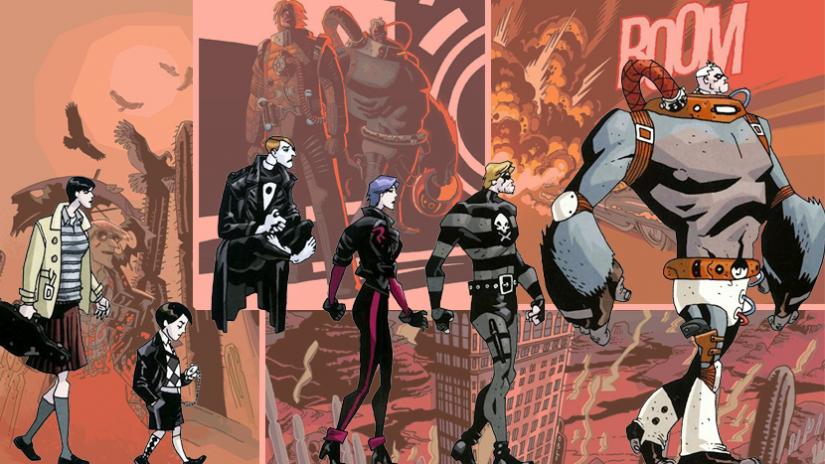Gerard Way is perhaps best known as the frontman of the iconic emo band My Chemical Romance, but in recent years he’s been a prolific writer of comic books as well. Gerard has a penchant for making bizarre, creative, and very entertaining comics. One of his best works, The Umbrella Academy, has been adapted into a TV show by Netflix. With that show’s Season 2 on the way and My Chemical Romance announcing a reunion show in Los Angeles, I thought now would be a good time to take a deeper look at Gerard Way’s contributions to the world of comics.
The Umbrella Academy, art by Gabriel Bá

The Umbrella Academy is the story of several children, born mysteriously with superpowers, adopted and raised to be a family/superhero team. So far, there are three volumes. Apocalypse Suite focuses on the Umbrella Academy’s continued attempts to prevent the end of the world, much like in the TV show. Dallas tells the story of Number Five’s mysterious past (future?) and introduces the time-traveling psychopaths, Hazel and Cha-Cha. The recently released Hotel Oblivion sees an army of the world’s worst villains escape from the extra-dimensional prison they were put in by the Umbrella Academy and their mad scientist father, Dr. Hargreeves.

Fans of the show should be aware that the Umbrella Academy comics are very different from the TV show. The TV show takes a more muted approach to superheroing, in terms of visuals and action. It’s a lot more slowly paced, allowing more time for character and relationship progression. The comics are full-on madcap superhero action. The characters wear superhero costumes and move at a frenetic pace from one adventure to another. The absurdism is cranked up to take advantage of the comic medium, but the off-the-wall tone of the TV show is present in the comics as well.

In addition to Gerard’s writing, The Umbrella Academy has some really good art. Gabriel Bá’s interior art is dynamic and crazy in just the right amount to match the story and the characters. It reminds me a lot of Paul Dini’s art for Batman: The Animated Series. In addition, the Apocalypse Suite covers by James Jean of Fables fame are wonderfully gothic and creepy, setting the tone for the rest of the comic just like good covers should. Reading The Umbrella Academy is a very different experience from watching the show, but an enjoyable one nonetheless.

The True Lives of the Fabulous Killjoys, with Shaun Simon, art by Becky Cloonan

This comic is a continuation of My Chemical Romance’s last album, Danger Days: The True Lives of the Fabulous Killjoys. It follows The Girl from the “Na Na Na” and “SING” music videos as she leads a new generation of Killjoys in the fight against the evil corporation of Battery City. There are tons of references to MCR’s music in this comic, and the glam-apocalypse aesthetic feels just like Danger Days. In addition, the album’s villain Scarecrow Korse returns, played in the music videos by Gerard’s friend, legendary comic book writer Grant Morrison. This comic is worth checking out for any fan of MCR’s music.

Doom Patrol, art by Nick Derington

Gerard Way’s Doom Patrol is a continuation of Grant Morrison’s wild, absurdist take on the DC Comics team of misfit superheroes. Like he usually does, Gerard leans all the way into the weirdness with this comic. There are streets with minds of their own and fictional characters being born into the real world. There’s a robot with a human brain and a woman with 63 personalities, each one with a different superpower. These are great comics with great art by Nick Derington. They do rely pretty heavily on the characters and continuity of Grant Morrison’s run, so I would recommend reading those first if you find Doom Patrol confusing.

Cave Carson has a Cybernetic Eye, with Jon Rivera, art by Michael Avon Oeming

This is a psychedelic take on retro super-spelunker Cave Carson. My favorite part of this fantastic journey deep under the earth is its take on the unstable-protagonist trope. The titular cybernetic eye causes Cave a lot of mental anguish and leads him to do some pretty crazy things, and although this is a common plot device in modern comics, Gerard and the Cave Carson crew put their own unique spin on it that make these comics really off-the-wall and fun. If you dig Gerard’s other comics, I recommend you check these out too.
